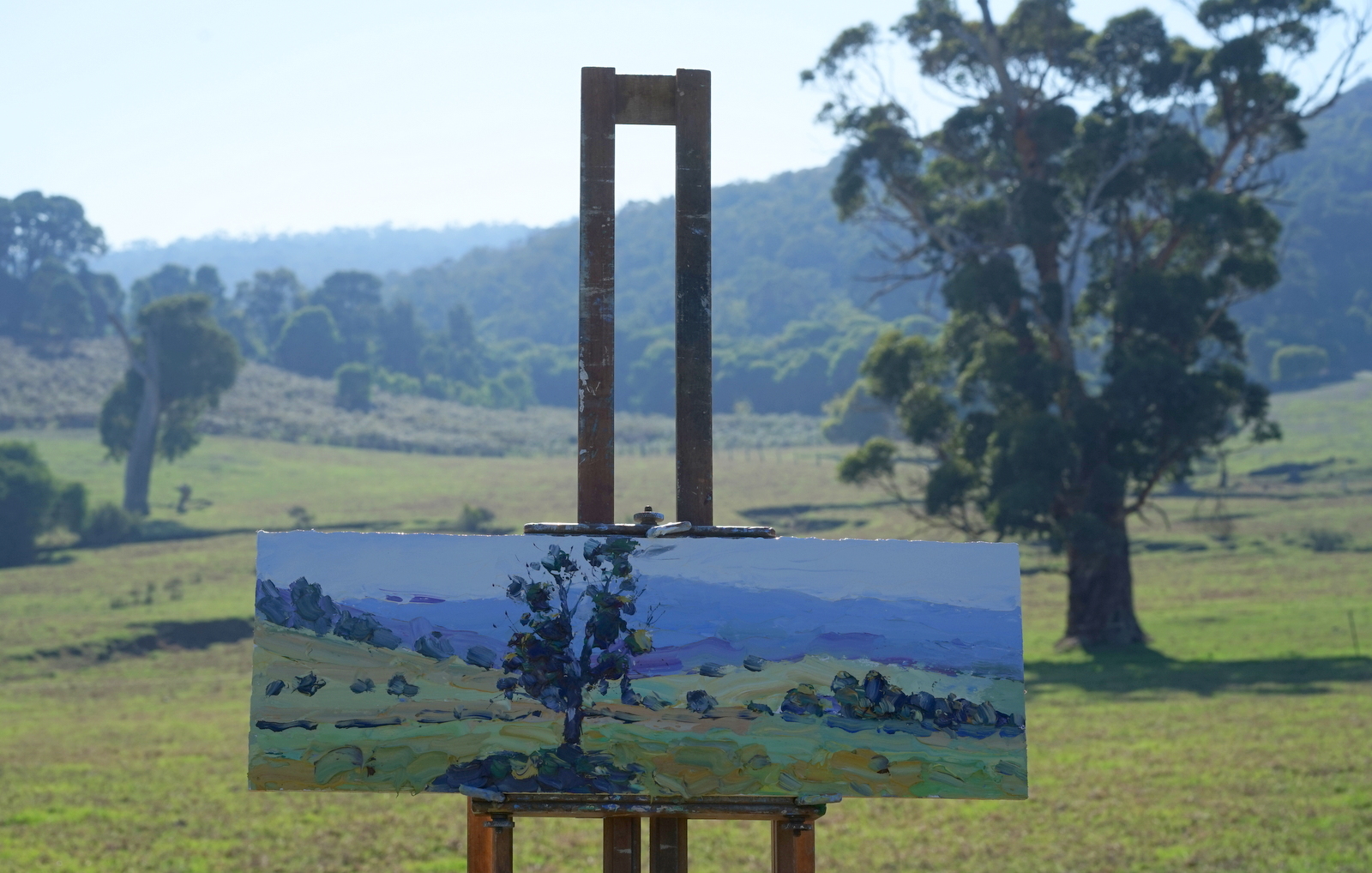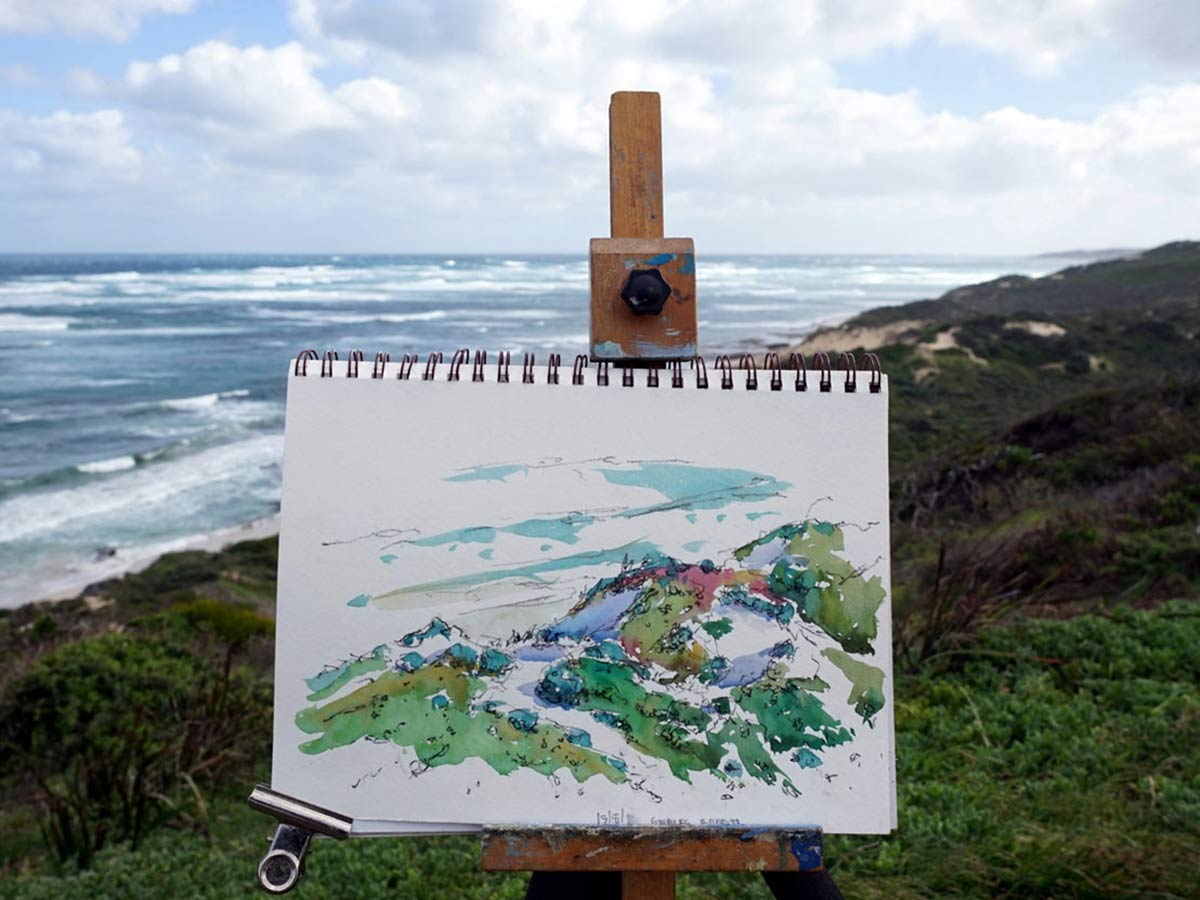For Sam each painting is the culmination of slow processes involving many personal artistic rituals formed following intense and extensive research over many centuries past into art techniques ,mediums and materials
Each artwork begins with a an engaging subject in the local environment noticed by the artist. This is followed up with many a return visit, at varying times of day, conditions and occasionally seasons to experience and capture the unique nuance of place . This essence becomes instilled in his minds eye
Then follows photos and lastly a plein air sketch . The studio process is next using a similarly slow and involved process developed by Sam to capture his subject his way.
View the Process
136cm x 120cm
Materials and Process
Like many Renaissance artists, I consider the pursuit of permanence in my work an important principal when choosing the correct materials. I view my paintings as like ‘time capsules’, hopefully to be viewed and felt in a similar manner as the day they were painted, in centuries to come. To this end I employ the following in my artwork.
Belgian Linen
The support chosen for my larger paintings is an acrylic primed Belgian linen. The best linen in the world is woven from flax grown in a small area between Normandy and Holland, and has been traditionally done so for about 500 years. Flax linen fibres are far stronger than cotton fibres, due to being 10 to 30 times longer
The linen is then stretched on Professional Quality Stretcher Bars, and requires a certain amount of skill and experience, of which I have been doing for over 25 years.
Paint
The paints used are either an acrylic emulsion or of a hand made oil. The paint chosen have pigments with the highest light fast rating (being ASTM 1 OR BWS 8:8:8), thereby minimising and negating fading issues. Many of the pigments in the paint are very expensive, but are irreplaceable when compared to many of the cheaper pigments. One such pigment is flake white. Although 5-10 times the price of modern white paints, the importance of flake white is two fold. Besides accelerating the drying rate of the paint film, it creates a stronger crosslink of the oil film and pigment thereby producing a more enduring painting.
To find out about Sam’s unique walnut oil process and the effects he achieves. Please click here
Tools
In order to push the boundaries of the technical side of my work, hand made brushes of various fibres (both natural and synthetic) were acquired from overseas due to their unavailability in Australia. These high quality brushes allowed me to manipulate the paint in such a way as to give me either detail or atmosphere to my paintings.
Protection
For future conservation purposes a non removable isolation coat was applied over the acrylic paint film prior to varnishing. This isolation coat physically separates the paint film from the non yellowing removable varnish. This will help protect the acrylic surface if the varnish is ever removed, making future cleaning and conservation easier. The archival varnish contains Ultra Violet Light Stabilisers to help protect colours from damaging light sources. With my oil paintings, the varnish used was developed by an American company in collaboration with the National Gallery of Art (Washington). It is a non yellowing synthetic varnish readily removed when required.
As a final method to increase the longevity of the painting, the back of the painting is covered with a foam core board and a layer of conservation polypropylene. Environmental fluctuations increase the expansion and contraction of both canvas and paint layers. With oils this can lead to sagging of the linen, paint cracking and finally delamination. This process is greatly reduced by sealing the reverse of paintings

Lapis Lazuli and Pigments (only used in the occasional painting)
Lapis lazuli has been one of the most revered pigments used by artists since medieval times. It was a pigment held in such high esteem as to be worth its weight in gold. Originally mined in Afghanistan, the lazurite (blue particle) was referred to as ‘from beyond the seas’, due to the origin of the pigment being sourced from across the ocean. Being used by the masters such as Da Vinci, Titian, and Vermeer, it was painted sparingly and only for special patrons like kings and popes. The cost was so prohibitive that when a painting was commissioned, the amount of lapis in a painting, was often stipulated in an agreement between the artist and client.
The reason for the high cost of the pigment is mainly due to the labour intensive process of extracting the blue particles from the contaminating calcite and pyrites. The extraction of lazurite was developed in the 14th century using gum rosin, gum mastic, and wax. Today the gum mastic can only be purchased from the Greek island of Chios, and is thus almost as expensive as the raw lapis. These gums/wax are heated with crushed lapis lazuli to form a dough like matter.
After a few days this is kneaded in a warm solution of lye, allowing the blue pigment to solubilize in the liquid whilst the impurities remain in the gum/wax. This takes several hours, and is repeated over a couple of days whilst changing the lye solution. The amount of lapis recovered varies from 3 to 5 percent. From 1 kg of rock, about 30 to 50 grams of blue is yielded.
After the blue is extracted, further purification by levigation is required. The final stage involves grinding the particles in water with a glass muller. This gives a blue of such a subtle beauty, that it is a complete joy and experience to paint with. There is no other blue like this. Cennini, a 14th century artist stated, ‘a colour illustrious, beautiful and most perfect, beyond all other colours’.
Although the blue is an outstanding colour, it has very unusual characteristics compared to current synthetic pigments. It has a gritty feel and thereby requires a different way of painting in order to apply the paint. It has to be glazed in thin layers or applied in a forgotten renaissance technique called ‘bottegiando’. These mineral pigments are also brutal on brushes, destroying more than a dozen on each painting.
The most obvious use for lapis lazuli is the sky and water within the landscape, especially coastal scenes. Another overlooked application is with the blue greys of cliffs, and other areas such as sand shadows. Whilst some of my paintings require lapis lazuli, not all of them do.
From my travels within Western Australia, I noticed the variety of minerals and rocks lying along roadsides and amongst gorges. From my research into Renaissance painting practices, I came across articles elaborating on many of the pigments used, and how they were purified.
Most of these pigments can be found in Western Australia, including Malachite and Chrysocolla located near Kalgoorlie, and the iron oxides around the Pilbara. The semi precious stone lapis lazuli originated from Afghanistan, and fortunately my travels did not require me to travel that distance.
An area of discovery for me is the use of black pigment. By charcoaling walnut husks (from Manjimup) and paper bark twigs (from Marble Bar), this has enabled me to gain a greater depth to my work. Other blacks used are tourmaline and vivianite (from north of Newman). Another technique used lately is the application of dried pigment such as charcoal and pastel over the top of paint.
Rather than use my walnut oil, I have decided to use the pigments with an acrylic emulsion. I am unaware of anyone doing this, but the reason for choosing acrylic is due to a few unique properties. A feature of this medium is that paint pigments exhibit a higher key or paler tonal range upon drying. Whereas oils darken the chroma of lapis lazuli, acrylic allows the particles to vibrate with more intensity.
I feel that combined with these unique pigments, I am able to express the brightness of the Australian landscape. I do not know how more connected to the landscape my paintings could be, than by using pigments from the earth itself.








